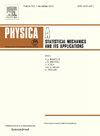全球动态中的加密货币:用机器学习分析加密波动指数和金融市场
IF 3.1
3区 物理与天体物理
Q2 PHYSICS, MULTIDISCIPLINARY
Physica A: Statistical Mechanics and its Applications
Pub Date : 2025-06-24
DOI:10.1016/j.physa.2025.130770
引用次数: 0
摘要
准确估计加密货币市场波动对投资者来说至关重要。加密波动率指数(CVI)是为了衡量市场对比特币和以太坊30天隐含波动率的预期而开发的,以满足对可靠预测日益增长的需求。本研究探讨了CVI与传统金融市场波动率的关系,包括黄金波动率指数(GVZ)、原油波动率指数(OVX)和标普500波动率指数(VIX)。另外还分析了三个变量:美元兑欧元汇率(USDEUR)、美联储利率(FED)和纳斯达克指数。研究的目的是解释性的:同时观察输入变量和CVI,以捕捉它们之间的复杂关系。利用Pearson相关、距离相关和互信息,我们证明了数据集中一些变量之间存在非线性关系。解释性分析使用机器学习技术进行,特别是随机森林(RF)算法和梯度增强机(GBM),以解释这些潜在的非线性相互作用。这些方法比标准线性模型更适合于识别复杂关系。特别是,RF算法达到了比GBM更好的精度水平,并且避免了过拟合。本文章由计算机程序翻译,如有差异,请以英文原文为准。
Cryptocurrency in global dynamics: Analyzing the Crypto Volatility Index and financial markets with machine learning
Accurate estimation of cryptocurrency market volatility is crucial for investors. The Crypto Volatility Index (CVI) was developed to measure the market’s expectations for the 30-day implied volatility of Bitcoin and Ethereum to address the growing demand for reliable predictions. This study explores the relationship between the CVI and the volatility of traditional financial markets, including the Gold Volatility Index (GVZ), the Crude Oil Volatility Index (OVX), and the S&P500 Volatility Index (VIX). Three other variables are also analyzed: the USD to EUR exchange rate (USDEUR), the Federal Reserve interest rate (FED), and the NASDAQ index. The aim of the research is explanatory: the input variables and the CVI are observed contemporaneously to catch the complex relation between them. Using Pearson correlation, distance correlation, and mutual information, we demonstrate the presence of non-linear relationships between some variables in the dataset. Explanatory analysis is conducted using machine learning techniques, specifically the Random Forest (RF) algorithm and Gradient Boosting Machines (GBM) to account for these potential non-linear interactions. These methods are better suited than standard linear models for identifying complex relationships. In particular, the RF algorithm reaches a better level of accuracy than GBM and avoids overfitting.
求助全文
通过发布文献求助,成功后即可免费获取论文全文。
去求助
来源期刊
CiteScore
7.20
自引率
9.10%
发文量
852
审稿时长
6.6 months
期刊介绍:
Physica A: Statistical Mechanics and its Applications
Recognized by the European Physical Society
Physica A publishes research in the field of statistical mechanics and its applications.
Statistical mechanics sets out to explain the behaviour of macroscopic systems by studying the statistical properties of their microscopic constituents.
Applications of the techniques of statistical mechanics are widespread, and include: applications to physical systems such as solids, liquids and gases; applications to chemical and biological systems (colloids, interfaces, complex fluids, polymers and biopolymers, cell physics); and other interdisciplinary applications to for instance biological, economical and sociological systems.

 求助内容:
求助内容: 应助结果提醒方式:
应助结果提醒方式:


